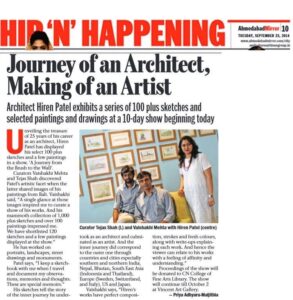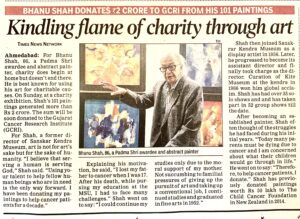For past 20 years, NRG Jagdish Vyas has been using creative tools to preserve Gujarati language in the hearts and homes of Indian Americans. The 65-year-old recently shifted to Ahmedabad with the same mission.
» Tej, 8, and Rishi, 6 – children of secondgeneration Indian-American Pritesh Vyas, an IT professional from Philadelphia — recite Asatyo mahi thee prabhu param satye tu lai ja every morning
» Anokhi Patel, 17, a pre-medicine student teaches Gujarati language to students at community temple during weekends in Baltimore
Tej, Rishi and Anokhi represent a group of children of second-generation Indian Americans who take pride in their Gujaratiness and love their mother tongue. At a time when language crusaders are struggling to preserve the legacy of Gujarati on the home turf, these NRG children narrate Be biladi ane ek vandro, Tarsyo kagdo, Khati draksh from the Panchatantra and Hitopadesh to other kids from their community.
It is due to the persistent efforts of people like NRG Jagdish Vyas, 65, that the Gujarati diaspora in the US is seriously concerned today about preservation of Gujarati language and culture. Now, Vyas has shifted to Ahmedabad to preserve Gujarati in the“homes and heart so four people”.
Since 1993, he has been into development of interactive Gujarati language-learning CD incorporating words, phrases, idioms, pronunciation, prayers, stories and poems. He claims to have distributed 80,000 copies of the CD among NRGs through community offices and temples in the US. while he is quite happy about the fact that second generation NRGs are passionate about preserving the language and culture, he says the same cannot be said for Gujaratis living in Gujarat.
“Unfortunately, while NRG kids in the US are being taught rhymes like Chakki chokha khaande chhe and Hathibhai toh jaada, here Gujarati children only know English rhymes like Twinkle twinkle and Chubby cheeks. There is no sense of belonging to our mother tongue and culture in Gujarat,” he says.
Vyas, who migrated to Florida in the US in 1979, pursed MBA and became the first Gujarati salesperson of a US pharmaceutical MNC. After setting and achieving sales targets for 15 long years, he grew interested in promoting his mother-tongue among NRGs like him. “After earning sufficiently to provide fo rmy family,I set up a motel,gas station and a store in Florida with my savings. In 1990, I got my mother shantaben, who was 75 then,to come and stay with my four-year-old daughter Shuchi and two-year-old Shivali. I was so happy that we were all together, finally. But little did I know that my mother had begun to feel lonely because she could only speak Gujarati whereas my daughters only understood English,” he
says.
It was this lack of connection between his mother and his daughters that made him realise what he had missed teaching his children. “One day, my mother came to me and told me she wanted to learn English so that she could communicate with my daughters. But I felt that my daughters first needed to learn Gujarati. It was their mother-tongue after all. I was so busy making money that I forgot to teach them Gujarati,” says Vyas.
And that was the turning point. Vyas attended seminars and workshops at Walt Disney Centre to learn how to teach kids language using audio visual aids. He gave five years towards developing interactive Gujarati language learning CD — Gauravvanti Gujarati — with the help of which he taught this daughters Gujarati.
“My children mastered Gujarati in a couple of years. But I was still not satisfied. I wanted other children like them to learn the language, too. So, I began distributing copies of the CD among my community members through temples and offices. Now, when I am happy that my efforts are bearing fruits back in the US, it pains me to know that such a beautiful language is not valued in a place it originated from. People here are slowly losing Gujarati from their homes and their hearts. That is the reason I decided to shift to Ahmedabad,” he says.
Vyas recently set up a studio in the city to develop interactive Gujarati language learning CDs and reach out to urbanites in the state. “The biggest unifier of people anywhere in the world irrespective of socio-economic differences is their language. We should learn to love, respect and preserve what unites us,” he says.
The story appeared as Cover Story of Ahmedabad Mirror, Sunday edition on May 19, 2013

